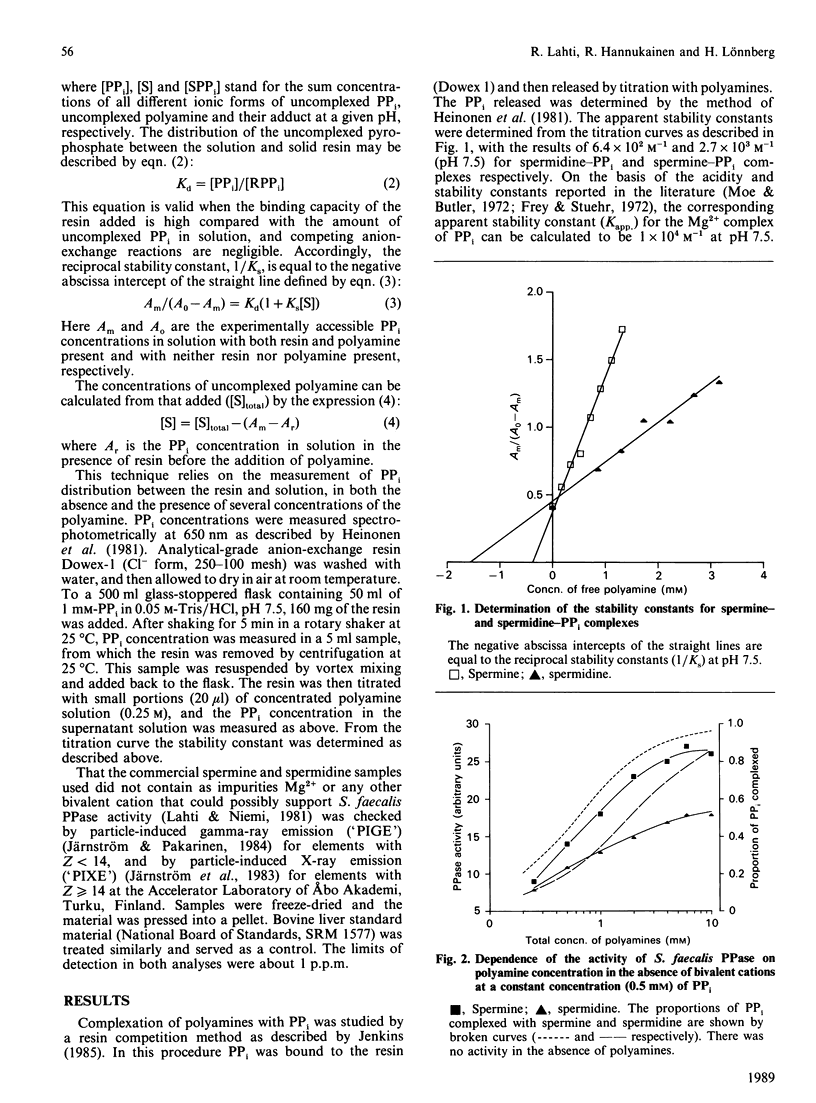Abstract
We have shown a dual role for Mg2+ in the hydrolysis of PPi catalysed by inorganic pyrophosphatase (PPase; EC 3.6.1.1) of Streptococcus faecalis; Mg2+ is necessary for the formation of the substrates, Mg1PPi2- and Mg2PPi0, and it also acts as an allosteric activator [Lahti + Jokinen (1985) Biochemistry 24, 3526-3530]. No activity can be observed with S. faecalis PPase in the absence of bivalent cations, which indicates that free PPi cannot serve as a substrate for this enzyme. However, significant activities were observed in the presence of spermine and spermidine, even though no bivalent cations were present. It was shown by particle-induced gamma-ray emission and particle-induced X-ray-emission analysis that the polyamines used were not contaminated with Mg2+ or any other bivalent cations that could support PPase activity. Hence it is obvious that polyamines are able to form a complex with PPi that serves as a substrate for PPase. The apparent stability constants for the 1:1 adducts of spermine and spermidine were estimated by a resin competition method. The values obtained at pH 7.5 were 2.7 X 10(3) M-1 and 6.4 X 10(2) M-1 respectively. Kinetic results further suggested that polyamines can also substitute for Mg2+ as an activator in vitro. The physiological significance of these polyamine effects were discussed.
Full text
PDF




Selected References
These references are in PubMed. This may not be the complete list of references from this article.
- Cooperman B. S. The mechanism of action of yeast inorganic pyrophosphatase. Methods Enzymol. 1982;87:526–548. doi: 10.1016/s0076-6879(82)87030-4. [DOI] [PubMed] [Google Scholar]
- Fairlamb A. H., Blackburn P., Ulrich P., Chait B. T., Cerami A. Trypanothione: a novel bis(glutathionyl)spermidine cofactor for glutathione reductase in trypanosomatids. Science. 1985 Mar 22;227(4693):1485–1487. doi: 10.1126/science.3883489. [DOI] [PubMed] [Google Scholar]
- Frey C. M., Stuehr J. E. Interactions of divalent metal ions with inorganic and nucleoside phosphates. I. Thermodynamics. J Am Chem Soc. 1972 Dec 13;94(25):8898–8904. doi: 10.1021/ja00780a042. [DOI] [PubMed] [Google Scholar]
- Gonzalez M. A., Cooperman B. S. Glutamic acid-149 is important for enzymatic activity of yeast inorganic pyrophosphatase. Biochemistry. 1986 Nov 4;25(22):7179–7185. doi: 10.1021/bi00370a062. [DOI] [PubMed] [Google Scholar]
- Heinonen J. K., Honkasalo S. H., Kukko E. I. A method for the concentration and for the colorimetric determination of nanomoles of inorganic pyrophosphate. Anal Biochem. 1981 Nov 1;117(2):293–300. doi: 10.1016/0003-2697(81)90725-9. [DOI] [PubMed] [Google Scholar]
- Heinonen J. New radiochemical method for assay of enzymes catalyzing the cleavage of inorganic pyrophosphate. Anal Biochem. 1970 Sep;37(1):32–43. doi: 10.1016/0003-2697(70)90255-1. [DOI] [PubMed] [Google Scholar]
- Jenkins W. T. A spectrophotometric resin competition procedure to determine dissociation constants for metal ion-nucleotide complexes. Anal Biochem. 1985 Mar;145(2):362–366. doi: 10.1016/0003-2697(85)90375-6. [DOI] [PubMed] [Google Scholar]
- Klemme J. H. Regulation of intracellular pyrophosphatase-activity and conservation of the phosphoanhydride-energy of inorganic pyrophosphate in microbial metabolism. Z Naturforsch C. 1976 Sep-Oct;31(9-10):544–550. doi: 10.1515/znc-1976-9-1011. [DOI] [PubMed] [Google Scholar]
- Lahti R., Heinonen J. Activity changes of inorganic pyrophosphatase of Streptococcus faecalis during batch culture. J Gen Microbiol. 1981 Jul;125(1):185–188. doi: 10.1099/00221287-125-1-185. [DOI] [PubMed] [Google Scholar]
- Lahti R., Heinonen J. Reversible changes in the activity of inorganic pyrophosphatase of Streptococcus faecalis. The effect of compounds containing SH-groups. Acta Chem Scand B. 1981;35(1):33–38. doi: 10.3891/acta.chem.scand.35b-0033. [DOI] [PubMed] [Google Scholar]
- Lahti R., Jokinen M. Kinetic model for the action of the inorganic pyrophosphatase from Streptococcus faecalis. Biochemistry. 1985 Jul 2;24(14):3526–3530. doi: 10.1021/bi00335a021. [DOI] [PubMed] [Google Scholar]
- Lahti R., Lönnberg H. Comparative kinetic studies on the two interconvertible forms of Streptococcus faecalis inorganic pyrophosphatase. Biochem J. 1985 Oct 15;231(2):485–488. doi: 10.1042/bj2310485. [DOI] [PMC free article] [PubMed] [Google Scholar]
- Lahti R. Microbial inorganic pyrophosphatases. Microbiol Rev. 1983 Jun;47(2):169–178. doi: 10.1128/mr.47.2.169-178.1983. [DOI] [PMC free article] [PubMed] [Google Scholar]
- Lahti R., Niemi T. Purification and some properties of inorganic pyrophosphatase from Streptococcus faecalis. J Biochem. 1981 Jul;90(1):79–85. doi: 10.1093/oxfordjournals.jbchem.a133471. [DOI] [PubMed] [Google Scholar]
- Lahti R., Suonpä M. Role of glutathione in the regulation of inorganic pyrophosphatase activity in Streptococcus faecalis. J Gen Microbiol. 1982 May;128(5):1023–1026. doi: 10.1099/00221287-128-5-1023. [DOI] [PubMed] [Google Scholar]
- Moe O. A., Butler L. G. Yeast inorganic pyrophosphatase. II. Kinetics of Mg 2+ activation. J Biol Chem. 1972 Nov 25;247(22):7308–7314. [PubMed] [Google Scholar]
- Nakai C., Glinsmann W. Interactions between polyamines and nucleotides. Biochemistry. 1977 Dec 13;16(25):5636–5641. doi: 10.1021/bi00644a039. [DOI] [PubMed] [Google Scholar]
- Randahl H. Characterization of the membrane-bound inorganic pyrophosphatase in Rhodospirillum rubrum. Eur J Biochem. 1979 Dec;102(1):251–256. doi: 10.1111/j.1432-1033.1979.tb06287.x. [DOI] [PubMed] [Google Scholar]
- Rapoport T. A., Höhne W. E., Reich J. G., Heitmann P., Rapoport S. M. A kinetic model for the action of the inorganic pyrophosphatase from bakers' yeast. The activating influence of magnesium ions. Eur J Biochem. 1972 Mar 27;26(2):237–246. doi: 10.1111/j.1432-1033.1972.tb01761.x. [DOI] [PubMed] [Google Scholar]
- Schreier E., Höhne W. E. Kinetic characterization of inorganic pyrophosphatase from Bacillus stearothermophilus. FEBS Lett. 1978 Jun 1;90(1):93–96. doi: 10.1016/0014-5793(78)80305-6. [DOI] [PubMed] [Google Scholar]
- Tabor C. W., Tabor H. Polyamines in microorganisms. Microbiol Rev. 1985 Mar;49(1):81–99. doi: 10.1128/mr.49.1.81-99.1985. [DOI] [PMC free article] [PubMed] [Google Scholar]
- Tabor H., Tabor C. W. Isolation, characterization, and turnover of glutathionylspermidine from Escherichia coli. J Biol Chem. 1975 Apr 10;250(7):2648–2654. [PubMed] [Google Scholar]
- Unemoto T., Tanaka M., Hayashi M. Effect of free magnesium and salts on the inorganic pyrophosphatase purified from a slightly halophilic Vibrio alginolyticus. Biochim Biophys Acta. 1973 Dec 19;327(2):490–500. doi: 10.1016/0005-2744(73)90432-4. [DOI] [PubMed] [Google Scholar]
- Welsh K. M., Cooperman B. S. Yeast inorganic pyrophosphatase. A model for active-site structure based on 113Cd2+ and 31P NMR studies. Biochemistry. 1984 Oct 9;23(21):4947–4955. doi: 10.1021/bi00316a019. [DOI] [PubMed] [Google Scholar]
- Yip L. C., Balis M. E. Polyamine-polyphosphate complexes as enzyme inhibitors. Biochemistry. 1980 Apr 29;19(9):1849–1856. doi: 10.1021/bi00550a019. [DOI] [PubMed] [Google Scholar]


